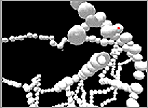
Art Infomation Index
|
|
![]()

|
Seiko Mikami
These works are based on the theory of molecular biology which states that "all objects can be artificially created by changing the chain reaction of molecular formation" . Naturally, Mikami's objective is not to prove this theory, but to apply this to media art in order to discover new potentials of form generation. This is not the kind of art that questions the aesthetic values of visible objects as seen in the norm of fine art in the past. It is an experimental art that interfaces the changes in the program (factor) itself and the changes of the visible morphosis (she calls this 'the interfacing of mathematics and perception'). The "work" mentioned here can be understood as an "event" which continuously changes by the participation of the people experiencing it. In "Molecular Informatics", the participant wears a pair of VR eyeglasses with an eye tracking sensor and enters a virtual space. The gaze becomes processed at real-time as information, and the molecules generate in a chain reaction synchronized with the tracks of the gaze. In other words, the continuing new generation of the molecular world becomes a reflection of how the participant sees the virtual world, and how he reacts to it. Even slight subconscious eye movements are processed into numerical data, instantly being expressed as molecular forms. Thus the people experiencing the work are forced to confront their unconscious self. "Molecular Informatics" will be exhibited at the DEAF (Dutch Electronic Art Festival) held in Rotterdam, Holland from September 17 to 29, and is currently being upgraded. In this latest version, by utilizing a style in which two participants share and experience the virtual space simultaneously (multiple gazes and their relationships), an unprecedented world will be presented to us. [Yukiko SHIKATA/Art Critic]
|
|
[London]
[Yoshitaka MOURI/Cultural Studies]
|
![]()
[home]/[Art Watch]/[Column]
Copyright (c) Dai Nippon Printing Co., Ltd. 1996
Network Museum & Magazine Project / nmp@acs.dnp.co.jp





